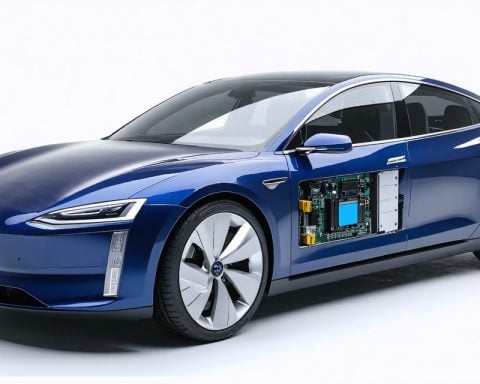- Washington State is launching a project for 2,500 EV charging stations across 136 multifamily properties.
- SWTCH Energy leads this initiative to integrate electrification into residential life.
- The Washington Department of Commerce invests $25.6 million through its Electric Vehicle Charging Program.
- Key partners, including Greystar and Wallbox, support the technological foundation for the project.
- The charging infrastructure aims to overcome barriers between sustainable living and multifamily housing.
- This initiative emphasizes that sustainable living should be accessible, regardless of housing type.
- The project signifies a broader shift towards greener urban living in Washington.
Washington State is poised to electrify its urban landscape by rolling out a groundbreaking network of 2,500 EV charging stations across 136 multifamily properties. As shiny EVs increasingly glide through city streets, residents in apartment complexes often face a logistical challenge: where do they charge their cars at home?
Enter SWTCH Energy, standing at the forefront of this transformation, with a mission to weave electrification into the fabric of everyday residential life. Imagine coming home to an apartment complex where sleek, intelligent charging stations stand ready to energize your vehicle as you rest. This is no future fantasy. It’s happening now, in the vibrant urban centers of Washington.
Backed by the substantial $25.6 million commitment from the Washington Department of Commerce’s Electric Vehicle Charging Program, this project promises to eradicate the barriers between multifamily living and sustainable transportation. Key partners like Greystar and Wallbox are laying the technological foundation, ensuring that residents are never left powerless.
These charging hubs stand as totems of progress, blending seamlessly with the architectural narrative of modern dwelling spaces, while offering the convenience and reliability that today’s eco-conscious residents demand. They mark the dawn of a new era—where sustainable choices no longer clash with the conveniences of urban life.
By integrating EV charging into residential properties, the project delivers a powerful message: Sustainable living should be accessible to all, transcending the boundaries of housing types. As Washington State drives forward in its electrifying journey, the charge in the air signals more than just renewable energy—it’s the beginning of a broader, greener shift in American urban living.
The Future of Electrified Urban Living: What Washington’s New EV Charging Network Means for You
How-To Steps & Life Hacks for Utilizing EV Charging Stations
1. Identify Accessible Stations: Locate nearby EV charging stations in your apartment complex or multifamily property using smartphone apps like PlugShare or ChargePoint. These platforms quickly display available slots and waiting times.
2. Reserve In Advance: During peak hours, ensure availability by booking a time slot ahead. Some networks allow you to schedule your station use to avoid conflicts.
3. Understand Charging Levels and Compatibility: Familiarize yourself with the different charging levels (Level 1, Level 2, and DC Fast Charging) and ensure that your EV model is compatible with the charging station’s hardware.
4. Maximize Off-Peak Charging: Most utility companies offer lower rates during off-peak hours. Plan your charging during these times to save on energy costs.
5. Routine Maintenance Checks: Regularly check for updates or maintenance notices from the EV charging network provider to ensure smooth operation.
Real-World Use Cases
– Reduced Carbon Footprint: Residents of these equipped properties will contribute significantly to reducing urban carbon emissions.
– Increased Property Value: These enhancements improve property values and attract eco-conscious renters or buyers, aligning with modern sustainability trends.
– Convenience for Commuters: For residents without private garages, these stations offer easy, reliable charging solutions, turning potential logistical headaches into seamless day-to-day operations.
Market Forecasts & Industry Trends
The global electric vehicle charging infrastructure market is projected to grow rapidly, with estimates ranging from $35 billion to over $63 billion by 2026, according to Allied Market Research. This growth is driven by increased EV sales, sustainability mandates, and urban electrification projects, such as the one in Washington.
Reviews & Comparisons
– SWTCH Energy: Known for its innovative integration of smart technology in EV charging networks, their solutions offer adaptability and ease of use for both property managers and residents.
– Competitors: Companies like EVBox and ChargePoint offer similar services but may vary in pricing models, installation speeds, and user interface experience.
Controversies & Limitations
While these installations represent significant progress, challenges such as initial installation costs and limitations of existing electrical infrastructure in older buildings may pose recurrent issues. The need for widespread grid upgrades remains a pressing concern.
Features, Specs & Pricing
– Wallbox Chargers: Typically integrate smart technology for load balancing and energy monitoring, with prices ranging from $600 to $1,000 per unit, not including potential rebates and incentives.
– SWTCH’s Infrastructure: Emphasizes flexibility in installation, with WiFi-enabled communication and remote troubleshooting as standard features.
Security & Sustainability
– Secure Transactions: Payment systems are designed with encryption and GDPR compliance to protect customer data.
– Sustainable Materials: Many of the components are made from recyclable materials, bolstering the environmental benefits.
Insights & Predictions
The successful implementation of this project could become a model for other states keen on reducing carbon footprints through residential solutions. The shift from individual to community infrastructure could foster a collective approach to achieving sustainable urban mobility.
Tutorials & Compatibility
Most installed units will offer easy-to-follow tutorials accessed via companion apps, ensuring user-friendly interfaces and compatibility with most electric vehicle models.
Pros & Cons Overview
– Pros: Enhanced convenience, eco-friendly image, potential for cost savings, modernizing infrastructure
– Cons: Upfront costs, reliance on stable power grid, potential competition for charging slots
Actionable Recommendations
– Upgrade Electrical Panels: Before installation, check if your residence needs electrical panel upgrades to support added load.
– Start Small: If you’re a property manager, consider piloting a small number of charging stations to test demand and smooth operational hitches.
– Engage Residents: Increase resident engagement through informational sessions and panels on EV benefits and usage.
For more about innovative sustainable energy solutions, visit SWTCH Energy.













